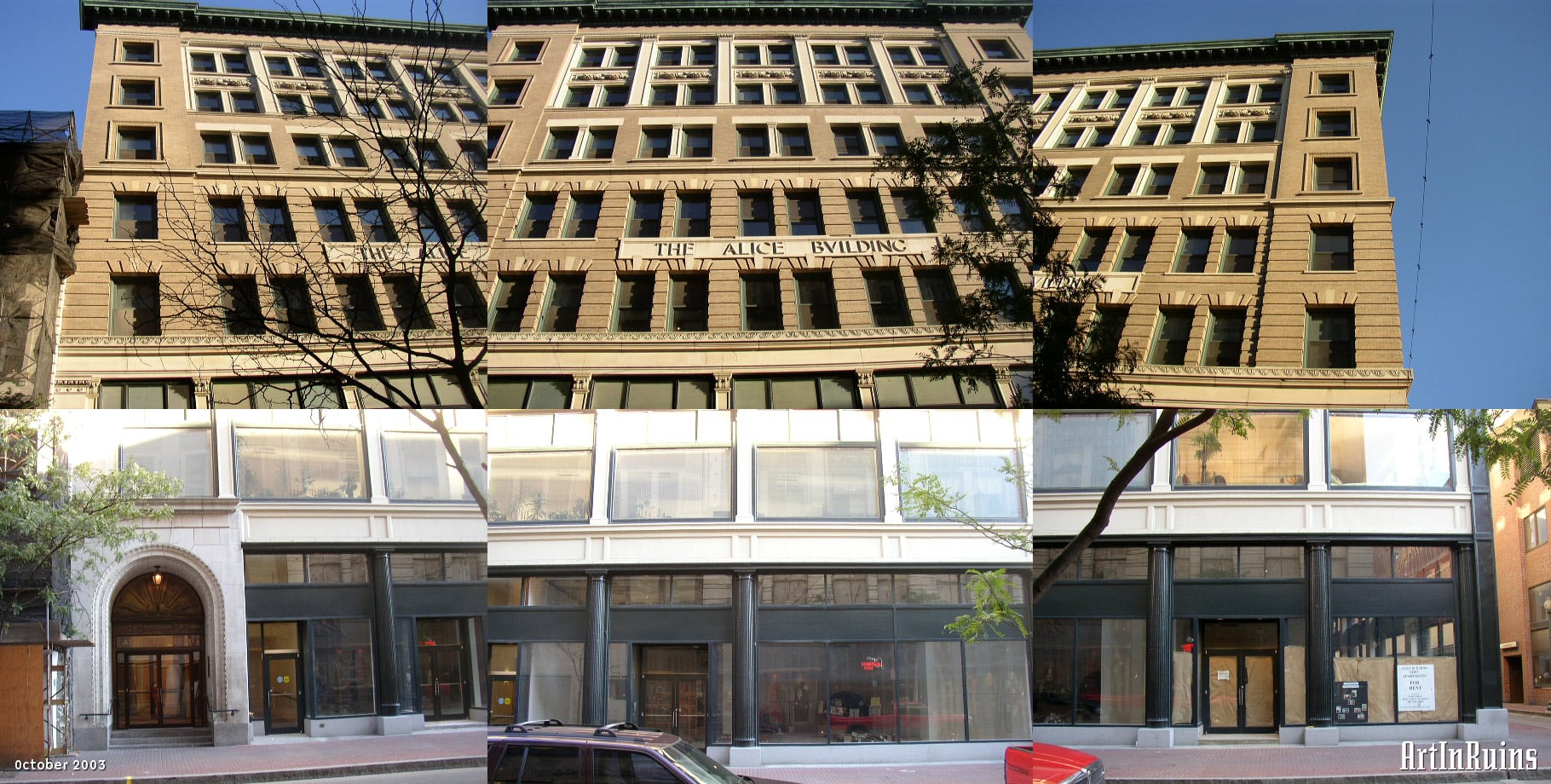Alice Building
A square, seven story commercial building converted to apartments in the early aughts — a frontrunner to the downtown residential boom
images of this Property
-

Intersection of Westminster and Union, circa 1955. The then Peerless building is on the left and the Alice building is on the right. Courtesy the Providence City Archives on Flickr -

A crude attempt to tile the whole building together back when digital cameras were a thing and phones with features that auto-stitched photos together didn’t exist -

-

-
![]()
-
![]()
Interior of one of the upper floors, showing the preserved individual storefront designs and surface finishes -
![]()
Another preserved architectural detail over the elevator bank -
![]()
-
![]()
-
![]()
-
![]()
Google Streetview, 2011 -
![]()
Photo from the Westminster Lofts website, Cornish Associates -
![]()
13 images: Press to view larger or scroll sideways to see more. Contribution by Google Streetview and Cornish Associates
About this Property
Redevelopment
The redevelopment of this commercial block was the first for Cornish Associates, early proponents of bringing residents downtown. Arnold “Buff” Chace’s vision was spurred on by a 1994 report called “Downcity Providence: Master plan and implementation plan.” The report was crafted by Andres Duany and Elizabeth Palter-Zyberk, best known for their pioneering work in New Urbanism, over the course of two years of research and observation.
The report led to the development of Westminster Street as a mixed-use commercial and residential corridor, shifting from heavily commercial to heavily residential. It helped the City create the Downcity Arts and Entertainment District which was passed by then-mayor Cianci in 1996. This program was the first of its kind in the country.
The repurposed Alice Building was converted to house 38 loft-style residential units above first-floor commercial and restaurant spaces. The exterior underwent a major cleaning and repointing of brick and stonework, with care taken to preserve and recreate details that had deteriorated. Each loft apartment features generous windows, high ceilings, and an open floor plan, between 750 and 2,000 square feet. Some of the seventh floor units feature a mezzanine level. Most interesting are the preserved corridor “streetscapes” that were created when the building was a collection of small shops on every floor.
Current Events
More photos of the spaces can be found at @WestminsterLofts on Instagram. Leasing information for commercial storefront space and residential lofts is available from WestminsterLofts.com.
History
Other Links
- Downtown Providence of today vastly different from city of early ’90s, Anne Wooten, Brown Daily Herald, March 2006
- Downcity: What is Past is Prologue, Philip C. Marshall, captured from Archive.org
The Alice building was the home to many business and commercial storefronts, as it is now. Some of the brand names include Kay Jewelers, Fanny Farmer, and more recently, Tazza Caffe.
From the National Register nomination form for the Downtown Providence Historic District, prepared by William McKenzie Woodward, Principal Historic Preservation Planner, 1984
236-250 Westminster Alice Building (1898): Martin & Hall, architects. 7-story, stone-trimmed, brick building with mid-20th-century storefronts; plate-glass display windows with tripartite transoms on second story; heavy cornice above second story, corner projecting pavilions on third through seventh stories; variety of surface texture on upper stories includes rustication of second and third stories and engaged columns at sixth and seventh stories; interior extensively remodeled on first story; upper stories retain original layout as shopping arcades.
The Alice Building was erected as an investment property by rubber magnate Joseph Banigan and named for his daughter, Mrs. James E. Sullivan. While the concept of a large building containing small shops had been realized in the Arcade of 1828, the precedent is without successor Downtown except for the Alice Building and the later Mason Building on Weybosset Street (now altered). A handsome commercial structure and an integral part of the streetscape, the Alice Building is increased in significance by its interior shopping arcade, a use of space completely belied by its standard exterior articulation.
From “Downtown Providence: Statewide Historical Preservation Report P-P-5,” prepared by the RIHPHC, May 1981
The growth of department stores and large specialty stores did not immediately replace the individual craftsman or one-man store. In fact, a number of commercial structures erected in the retail area around the turn-of-the-century were built specifically to house these small operations, which must have benefitted from proximity to other retail enterprises. Both the Alice Building 1898 at 236 Westminster Street and the Mason Building circa 1910 at 165 Weybosset Street originally featured shopping arcades on the upper floors, each small shop having a storefront on the corridor. Tailors, milliners, seamstresses, and dressmakers occupied these shops, as well as quarters in more conventional commercial structures, such as the Kinsley Building 1912, the William H. Low Building 1894, or the Caesar Misch Building 1903.








